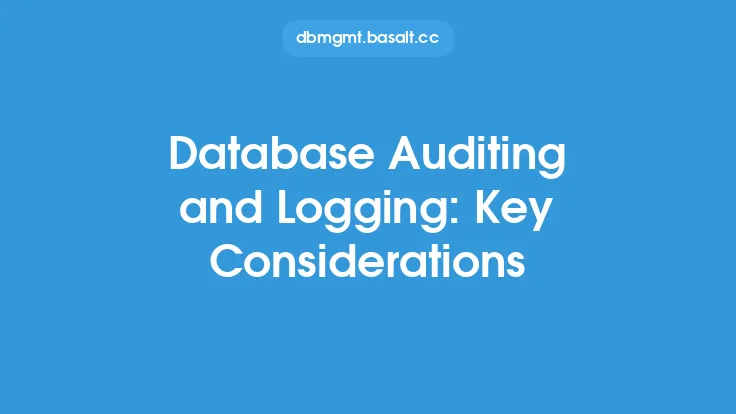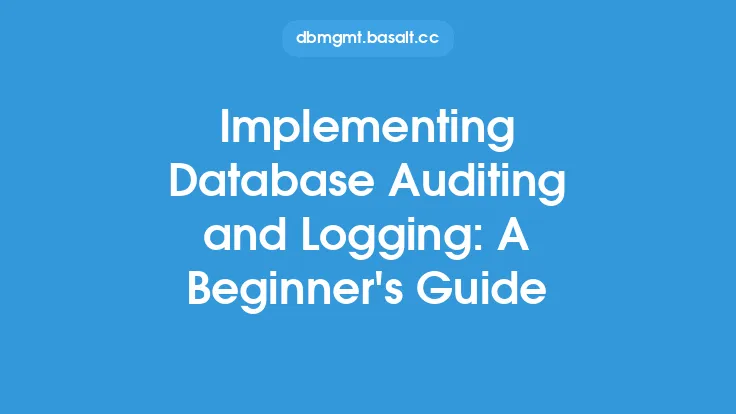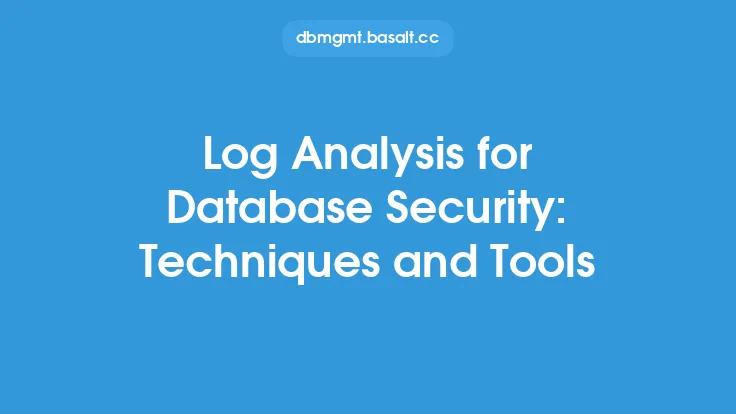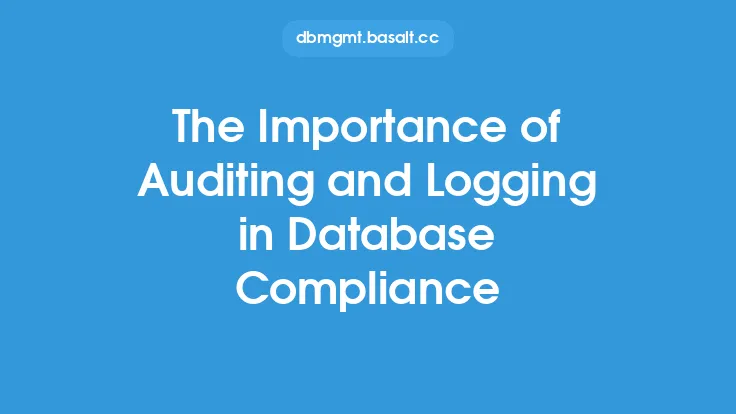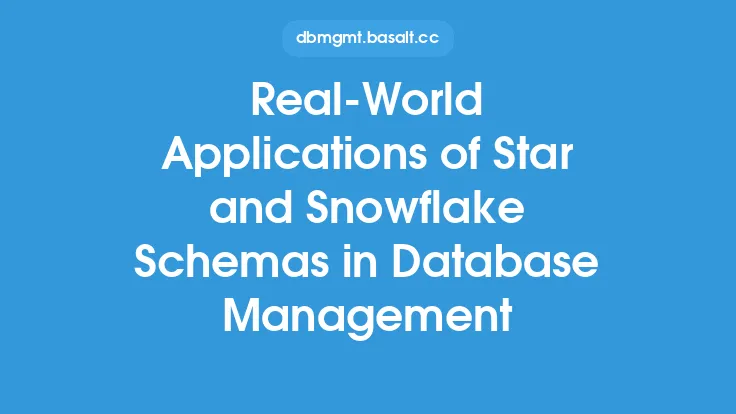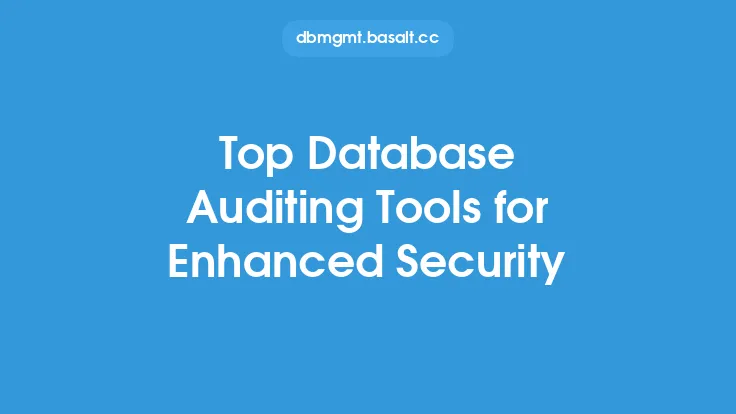Database security is a critical aspect of any organization's overall security posture, and auditing and logging are essential components of a comprehensive database security strategy. Auditing and logging provide a record of all database activities, allowing organizations to detect and respond to security incidents, comply with regulatory requirements, and improve overall database security. In this article, we will explore the importance of auditing and logging in database security, and provide real-world examples of how these practices can be implemented to protect databases from unauthorized access, data breaches, and other security threats.
Introduction to Database Auditing
Database auditing involves the collection and analysis of data related to database activities, such as login attempts, queries, and changes to database structures. The goal of database auditing is to provide a clear understanding of who is accessing the database, what actions they are performing, and when these actions are taking place. This information can be used to identify potential security threats, detect unauthorized access, and comply with regulatory requirements. Database auditing can be performed using a variety of tools and techniques, including native database auditing tools, third-party auditing software, and manual auditing methods.
Logging in Database Security
Logging is the process of recording database activities, such as login attempts, queries, and errors, in a log file or other centralized repository. Logging provides a detailed record of all database activities, allowing organizations to track changes, detect security incidents, and troubleshoot database issues. There are several types of logs that can be collected in a database environment, including system logs, application logs, and security logs. System logs record system-level events, such as startup and shutdown events, while application logs record application-level events, such as login attempts and queries. Security logs record security-related events, such as authentication attempts and access control changes.
Real-World Examples of Auditing and Logging
There are several real-world examples of how auditing and logging can be used to improve database security. For example, a financial institution may use auditing and logging to track all access to sensitive financial data, such as credit card numbers and social security numbers. This can help the institution detect and respond to potential security incidents, such as unauthorized access or data breaches. Another example is a healthcare organization, which may use auditing and logging to track all access to electronic health records (EHRs). This can help the organization comply with regulatory requirements, such as the Health Insurance Portability and Accountability Act (HIPAA), and protect sensitive patient data.
Benefits of Auditing and Logging
There are several benefits to implementing auditing and logging in a database environment. These benefits include improved security, compliance with regulatory requirements, and enhanced troubleshooting capabilities. Auditing and logging can help organizations detect and respond to security incidents, such as unauthorized access or data breaches, by providing a clear understanding of who is accessing the database and what actions they are performing. Auditing and logging can also help organizations comply with regulatory requirements, such as HIPAA and the Payment Card Industry Data Security Standard (PCI DSS), by providing a detailed record of all database activities. Finally, auditing and logging can help organizations troubleshoot database issues, such as performance problems or errors, by providing a detailed record of all database activities.
Best Practices for Auditing and Logging
There are several best practices that organizations can follow to implement effective auditing and logging in their database environments. These best practices include implementing a centralized logging solution, using a standardized logging format, and regularly reviewing and analyzing log data. A centralized logging solution can help organizations collect and analyze log data from multiple sources, while a standardized logging format can help organizations ensure that log data is consistent and easy to analyze. Regularly reviewing and analyzing log data can help organizations detect and respond to security incidents, comply with regulatory requirements, and troubleshoot database issues.
Common Challenges and Limitations
There are several common challenges and limitations to implementing auditing and logging in a database environment. These challenges and limitations include the potential for log data to become overwhelming, the need for specialized skills and expertise, and the potential for auditing and logging to impact database performance. To overcome these challenges and limitations, organizations can implement a centralized logging solution, use automated log analysis tools, and carefully plan and configure their auditing and logging strategies. By doing so, organizations can ensure that their auditing and logging practices are effective, efficient, and aligned with their overall security and compliance goals.
Future of Auditing and Logging
The future of auditing and logging in database security is likely to be shaped by several trends and technologies, including the increasing use of cloud-based databases, the growing importance of artificial intelligence and machine learning, and the need for more effective and efficient log analysis tools. As more organizations move their databases to the cloud, they will need to implement auditing and logging strategies that are tailored to cloud-based environments. The use of artificial intelligence and machine learning can help organizations analyze log data more effectively and efficiently, while the development of more advanced log analysis tools can help organizations detect and respond to security incidents more quickly and effectively. By staying ahead of these trends and technologies, organizations can ensure that their auditing and logging practices remain effective and aligned with their overall security and compliance goals.
